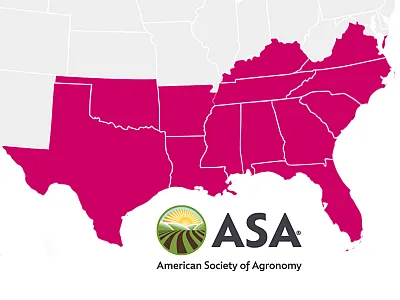Damage Control: Managing Canola’s Worst Enemy on the Canadian Prairies
No Evidence Yet for Flea Beetle Resistance to Neonicotinoids
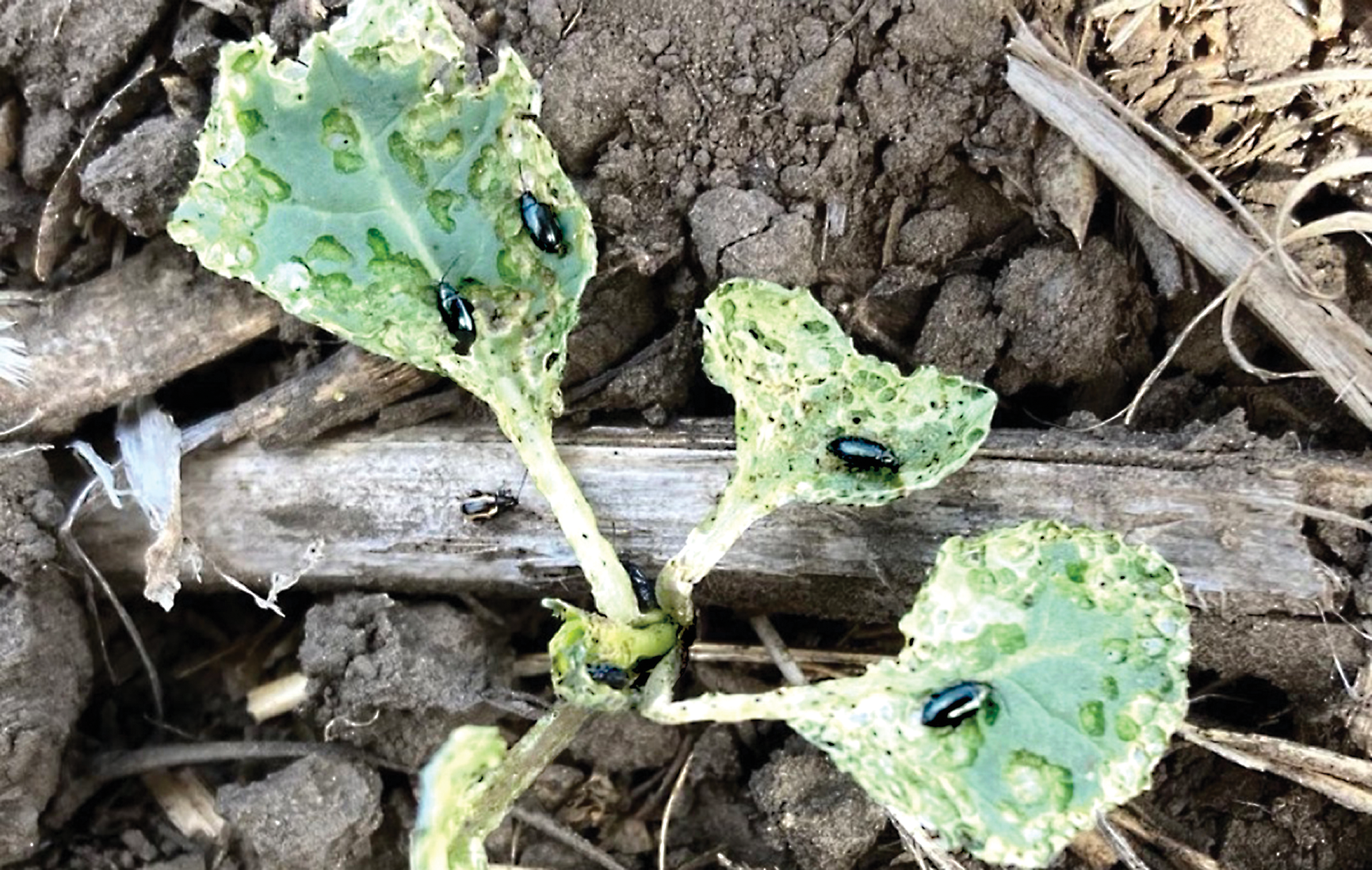

Managing flea beetle damage constantly challenges Canada’s canola growers. High populations have many producers speculating whether flea beetles have evolved resistance to common insecticidal seed treatments. Here’s a summary of the situation with insecticides and canola’s worst enemy on Canada’s prairies. Earn 0.5 CEUs in Integrated Pest Management by reading this article and taking the quiz.
Managing flea beetle damage constantly challenges Canada’s canola growers. High populations have many producers speculating whether flea beetles have evolved resistance to common insecticidal seed treatments. Canadian entomologists have not documented resistance to neonicotinoids among flea beetles; still, plenty of opinions abound. Here’s a summary of the situation with insecticides and canola’s worst enemy on Canada’s prairies.
Know the Enemy
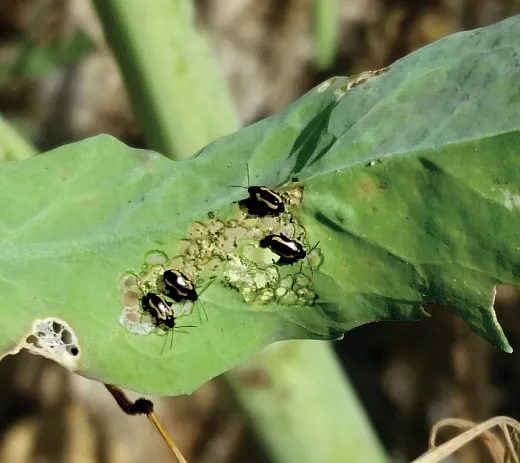
Flea beetles wake up in the spring, ready to eat, after overwintering as adults. At least eight species feed on canola grown in Canada, according to the Canola Council of Canada. Two cause most of the damage: crucifer flea beetles (Phyllotreta cruciferae Goeze) and striped flea beetles (Phyllotreta striolata F.).
These two flea beetle species are not created equal. One major difference is that adult striped flea beetles emerge from overwintering one to four weeks earlier than crucifer flea beetles emerge. These staggered emergence dates bring an avalanche of flea beetles into canola fields. This may lead some to wonder if seed treatments are working. “If flea beetle populations are very heavy, it is possible that the feeding scars left may have some questioning the effectiveness of the seed treatments,” says John Gavloski, Manitoba Agriculture entomologist.
The two species are also not created equal when it comes to neonicotinoids. Striped flea beetles exhibit a slight natural tolerance to the most common neonicotinoid seed treatments—which have higher rates of control in crucifer flea beetles—and that natural tolerance could be helping give rise to suspicions of resistant populations.
Tolerance vs. Resistance
Group 4A insecticides are the neonicotinoids longest used to treat canola. These include products with active ingredients clothianidin (Prosper EverGol from Bayer and Vercoras from BASF) and thiomethoxam (Helix Vibrance from Syngenta).
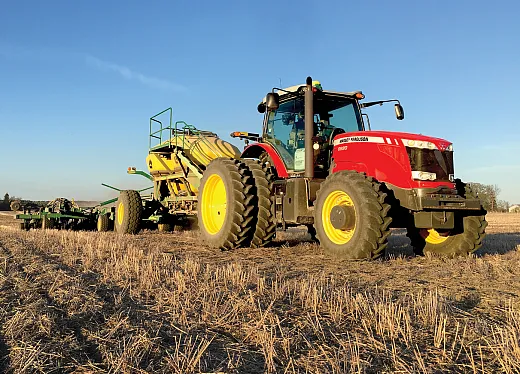
The striped flea beetle’s tolerance to Group 4A neonicotinoids, compared with crucifer flea beetles, is long known. In a study published in the Journal of Economic Entomology in 2008, Alberta entomologists reported striped flea beetles were more tolerant to neonicotinoid seed treatments than were crucifer flea beetles. University of Alberta entomologists repeated the 2008 study this season; they are also leading the effort to test for neonicotinoid resistance in flea beetles across the Prairie Provinces.
Entomologists think neonicotinoid tolerance in striped flea beetles is related to flea beetle biology. Striped flea beetles are known to detoxify and sequester glucosinolates and their breakdown products. “This leads us to believe there could be other detoxification mechanisms in the beetles that allow them to detoxify neonicotinoids,” says Boyd Mori, University of Alberta entomologist. That tolerance could allow some striped flea beetles to survive feeding on canola grown from neonicotinoid‐treated seeds, he says.
However, no research has yet documented flea beetle resistance to Group 4A neonicotinoids. Remember: Resistance is indicated by genetic proof that flea beetle populations have evolved insecticide resistance. “The striped flea beetle may have already had some natural (tolerance) against neonicotinoids rather than evolved resistance to the neonicotinoids,” Mori reiterates.
It is well known—and documented—that striped and crucifer flea beetles are frequently present in population numbers that can overwhelm the protection provided by traditional seed treatments. Seeking to enhance that first insecticidal defense against flea beetles, crop protection firms have combined neonicotinoids with other chemical families. The Group 4D seed treatment Buteo (Bayer) contains active ingredient flupyradifurone (neonicotinoids‐butenolides). Group 28 insecticides Lumiderm (Corteva) and Fortenza (Syngenta) have active ingredient cyantraniliprole (diamides). Syngenta’s Fortenza Advanced combines Groups 28 and 4C, active ingredients cyantraniliprole and sulfloxaflor (neonicotinoids‐sulfoximines).
Mori and his research team, in Alberta, are evaluating how these newer seed treatments stack up against past tools. “We are testing some of the new non‐neonicotinoid seed treatments although they are only available with a neonic base treatment,” he says. “In my opinion, under low to moderate flea beetle pressure, the neonicotinoid seed treatments are effective.”
The importance of using existing seed treatments was startlingly apparent during the 2022 season in Saskatchewan research plots, says Tyler Wist, Agriculture and Agri‐Food Canada (AAFC) research scientist in field crop entomology. Based in Saskatoon, Wist evaluated canola plots where seed with a standard neonicotinoid package grew alongside seed treated only with a fungicide. “Plants in the plot without neonicotinoids would be just eaten to the ground,” Wist says.
Seed treatments provide more than just canola seedling protection. Plants that survived in Wist’s untreated plots were also slower to develop, which causes later yield and quality problems. “We saw an average yield difference of 18 bushels to the acre between seed treated with neonicotinoids and seed that wasn’t—and that was just the average yield difference,” Wist says. “Anytime we didn’t have the seed treatment on there, the yield was really poor.”
Weather can have an outsized impact on the effectiveness of canola seed treatments. In Wist’s plots during the 2022 season, conditions were hot and dry just when crucifer flea beetles were ready to eat. “When it dries up, all those little bites on the plant let all the moisture out, and your plant just dries up. Plants just turn into powder and disappear,” Wist says.
It is easy to see, then, how flea beetles bring a natural advantage with them in attacking canola. The first to awaken from overwintering—striped flea beetles—have a biology that has some tolerance to common canola seed treatments. But if canola is seeded later, or cool temperatures delay seedling growth, later‐emerging crucifer flea beetles can bring a second wave of flea beetle pressure.
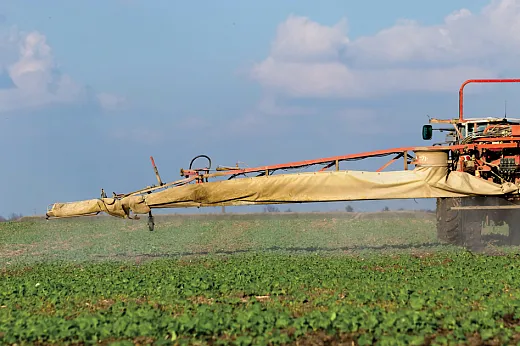
Later Seeding Dates Key
Early planting—which some attempted in the past to avoid flea beetle emergence—is not a reliable control strategy, as underscored by the research plots in Saskatchewan. “The striped flea beetle comes out two to three weeks earlier than the crucifer flea beetle,” Wist says. “So an early planting doesn’t work by itself for flea beetle control.”
Even worse, Wist says that flea beetle pressure appears to intensify when both striped and crucifer species are present on canola seedlings. He hypothesizes this could be due to competition between the flea beetle species: They may actually eat more aggressively when another flea beetle species is present, perceiving an existing threat to the food supply. Wist’s research this season sought to further investigate this question.
Entomologists on the Prairies now recommend seeding dates that will result in quick germination and early growth for canola. Some Manitoba producers saw clear benefits to later‐seeded canola in 2022, according to the Summary of Insects on Crops in Manitoba in 2022, compiled by John Gavloski. “In some areas, later‐seeded canola received less damage and had more rapid growth than earlier‐seeded canola,” he says.
Seeding canola into a warmer seedbed promotes faster growth to the four‐leaf stage. “The challenge canola growers face is to get the canola plants to a stage where it can naturally tolerate flea beetle feeding (three‐ to four‐leaf stage) without having significant feeding injury,” Gavloski says. “If they can successfully do that, there is less risk of foliar insecticide applications being needed.”
But later seeding is also not the panacea for flea beetle control because flea beetles love hot and dry conditions. In Manitoba in 2022, slow growth in some fields in early June and soil crusting hampered canola seedling development. Producers in Manitoba’s Eastern, Central, and Southwest regions all reported canola reseeding due to flea beetle injury. “In some instances, reseeding was due to a combination of flea beetle feeding and other stresses such as crusting and flooding to a lesser extent. Some ended up reseeding after multiple spray events,” writes Gavloski in the insect summary.
Canola seed treatments have about a three‐week residual from planting date. You might see four weeks if weather is not conducive to flea beetle feeding. “If canola can get to the three‐ to four‐leaf stage within three to four weeks of the date of seeding, the risk of having to do foliar applications will be reduced,” Gavloski says.
To summarize, the Canola Council of Canada says seed treatments may be more likely to fail:
- Where striped flea beetles are the most abundant species
- When above‐average rainfall causes saturated soil conditions during germination and seedling emergence
- When high temperatures (68 to 86°F) occur during germination and seedling emergence
Foliar Applications Remain Necessary
The traditional threshold is 20 to 25% damage for applying foliar insecticides for flea beetle control. Since the combination of both striped and crucifer flea beetles often overwhelm canola seedlings, producers have more often had to apply one or more foliar applications to attempt to get the seedlings to the three‐ and four‐leaf stage.
Fortunately, flea beetles show neither tolerance nor resistance to the common foliar insecticides used by canola growers. Researchers and the canola industry are closely monitoring issues around foliar application. “Data from our lab collected at only three sites in Alberta [in 2022] found no evidence of (flea beetle) resistance to a synthetic pyrethroid with active ingredient deltamethrin,” Mori says. “This was based on a limited number of sites confined to Alberta.”
Observations in Saskatchewan confirm the efficacy of foliar applications. “I don’t think we’ve got resistance building up against any of the foliar insecticides,” Wist says. “Usually those (foliar applications) are a straight pyrethroid.”
Other Additions or Alternatives to Seed Treatments?
One possible long‐term strategy for preventing flea beetle damage is breeding more lines of hairy canola. Flea beetles are far less likely to prefer brassicas with abundant trichomes. Researchers at AAFC and the University of Saskatchewan have investigated the “hairy” trait. That project found that the presence of hairs is controlled by a single gene with trichome abundance controlled by additional genes. Two lines of hairy canola were developed that could be used in plant breeding.
However, according to the final project report, the hairy canola phenotype requires the overexpression of two transgenes to reduce expression of the endogenous gene, “which may be too complicated to enter into already complicated private‐sector breeding programs,” according to the researchers. They also cited patent restrictions and potential business impacts as barriers to developing commercial lines of transgenic hairy canola.
Researchers at the AAFC Saskatoon Research Centre are now developing hairy canola lines using canola that showed natural resistance to flea beetles by growing trichomes on the canola leaves and stems. The project began in 2018 and is funded by government and canola industry groups.
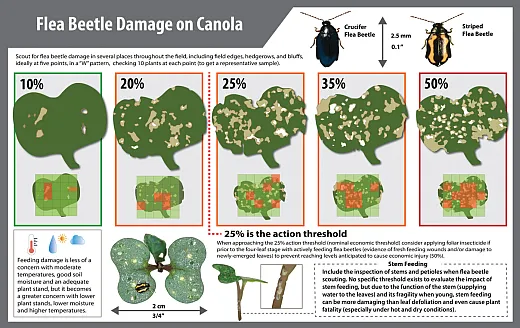
In short: hairy canola resistant to flea beetle may be a future option but is unlikely in the next few years. Advanced insecticides may also be a good possibility for future flea beetle control. “RNA‐based insecticides for flea beetle control may be another option, but once again not likely in the next few years,” Gavloski says.
Tools are in the pipeline to help Prairie producers better evaluate when foliar applications are warranted. With the rise in canola prices since 2019, producers can be less hesitant to spend for foliar applications. Seedling damage of 20 to 25% remains the standard for applying foliar insecticides, but it may be difficult to accurately judge seedling damage based on visual assessment.
The Saskatchewan Ministry of Agriculture has funded a project working on computer models that can look at a picture of a damaged canola plant and have the computer identify what percentage of damage that is. “Hopefully, in the future, you’ll be able to just point your cell phone at 10 plants, and it will give you an average damage so that you don’t have to try to estimate the damage on each individual plant,” Wist says. “If we can automate that process and make it more precise by taking human error out, that’ll be a really good thing for agriculture on the Prairies.”
Helpful Resources
- Flea beetle page from the Canola Encyclopedia: canolacouncil.org/canola‐encyclopedia/insects/flea‐beetles/
- Hairy canola report summary from SaskCanola: https://bit.ly/45kwqKj
Self-Study CEU Quiz
Earn 0.5 CEUs in Integrated Pest Management by taking the quiz. For your convenience, the quiz is printed below. The CEU can be purchased individually, or you can access as part of your Online Classroom Subscription.
- What known element of striped flea beetle biology might hint at how they tolerate neonicotinoids?
- They wake up in the spring after overwintering as adults.
- They can detoxify and sequester glucosinolates and their breakdown products.
- They emerge from overwintering earlier than other flea beetle species.
- They prefer canola with abundant trichomes.
- Seed treatments may be more likely to fail
- where crucifer flea beetles are the most abundant species.
- when above-average rainfall causes saturated soil conditions during germination and seedling emergence.
- when temperatures between 54 and 67°F occur during germination and seedling emergence.
- Both a and c.
- The most common neonicotinoid seed treatments have higher rates of control in crucifer flea beetles compared with striped flea beetles.
- True.
- False.
- Which group of insecticides are the neonicotinoids longest used to treat canola?
- 28.
- 3A.
- 4D.
- 4A.
- Flea beetles love hot and dry conditions.
- True.
- False.
Text © . The authors. CC BY-NC-ND 4.0. Except where otherwise noted, images are subject to copyright. Any reuse without express permission from the copyright owner is prohibited.




